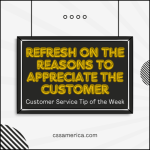
What makes a relationship? Many actions can make or break a relationship, but all solid relationships require at least two things: Communication and Caring. And customer relationships are no different in this respect.
No Communication = No Connection
If we don’t have some frequency of dialogue with the customer, then we not only are not top-of-mind, but we’re not even “bottom-of-mind.” We are not in the mind. They don’t think of us, they don’t consider us because the relationship has gone stale.
Now caring is in the eye of the beholder. How one person defines whether they are cared for by the other may differ from individual to individual. But if we put things in the context of the customer relationship, there are some more consistent realities. Communicating with the customer just to sell isn’t relationship-building. A lack of communication isn’t relationship-building.
What Caring for the Customer Requires
Caring requires that people feel like they’re viewed as an individual – that we value them. It requires that we usually listen more than talk. It means that we try to understand their issues, needs, and goals, and – if they want more than the listening ear – we address those issues, needs, and goals.
So much of what I just described suggests that we can – and MUST – improve customer relations through research, and CSS is conducting a great deal of research in this COVID-19 environment because our clients understand this truth.
Customer research done correctly involves a company asking a customer a question. It involves the company seeking information from the customer, ultimately for the customer. Sometimes, well-designed research instruments convey caring for the customer and valuing of the customer just by how the tools are worded and what questions are asked.
Design with the Customer in Mind
What do you need to know about the customer to help them? What do you need to learn about them to best serve them? How do you identify their priorities, their issues, their concerns, their perceptions, their preferences? And how do you construct these questions in such a way that you convey that you care? We’re talking about research, and we’re not necessarily saying it’s purely web-based surveys. This can include one-on-one interviews, phone follow-up from account representatives, or check-in calls from staff. This could include informal e-mail requests, or it could include facilitated ZOOM focus groups.
Whatever it is, do enough of it to know enough about as many of your customers as possible to help them. If you professionally design with the conveying that you care in mind, you will improve customer relations.























